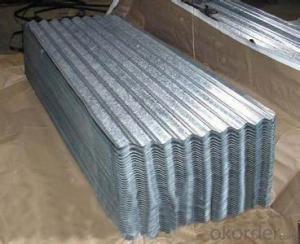Hot Dipped Galvanized Steel Coil In Sheets
- Loading Port:
- Tianjin
- Payment Terms:
- TT OR LC
- Min Order Qty:
- 25 m.t.
- Supply Capability:
- 100000 m.t./month
OKorder Service Pledge
OKorder Financial Service
You Might Also Like
Hot Dipped Galvanized Steel Coil In Sheets
1.Structure of Hot Dipped Galvanized Steel Coil In Sheets
Hot Dipped Galvanized Steel Coil In Sheets is one kinds of building material on construction. Galvanized coil, steel sheet in melting zinc trough, the sticking of a layer of zinc sheet. At present mainly adopts continuous galvanizing process, namely the continuous roll of steel plate in the melt zinc plating tank made of galvanized steel sheet; Alloying of galvanized steel. This kind of steel plate is made by hot dip method, but after the slot, immediately heated to a temperature of about 500 ℃, it make the generation of zinc and iron alloy membrane. This kind of galvanized volumes with good coating of the sex and weldability.
2.Main Features of Hot Dipped Galvanized Steel Coil In Sheets.
1) Rust-proof
2) Water-proof
3)Durable using
3. Hot Dipped Galvanized Steel Coil In Sheets Images


4. Hot Dipped Galvanized Steel Coil In Sheets Specification
1)Based raw material: Hot rolled steel coils or Cold rolled steel coils
2) Thickness
3) Width
4)Coating mass
5) Spangle
6)Surface treatment
7)Coil inner diameter
5.FAQ of Hot Dipped Galvanized Steel Coil In Sheets
We have organized several common questions for our clients,may help you sincerely:
①How about your company?
A world class manufacturer & supplier of castings forging in carbon steel and alloy steel,is one of the large-scale professional investment casting production bases in China,consisting of both casting foundry forging and machining factory. Annually more than 8000 tons Precision casting and forging parts are exported to markets in Europe,
②How to guarantee the quality of the products?
We have established the international advanced quality management system,every link from raw material to final product we have strict quality test;We resolutely put an end to unqualified products flowing into the market. At the same time, we will provide necessary follow-up service assurance.
③How is the packaging and delivery?
Exporting Package with the steel material cover and the delivery term is based on the project.
- Q: I'm trying to bend stainless steel spoons, forks knives etc. for an art project. Will heating them help bend them into certain shapes or will heat only strengthen it? What is the best way to bend stainless steel?
- Refer okorder /
- Q: Can steel coils be coated with anti-static materials?
- Yes, steel coils can be coated with anti-static materials. Anti-static coatings are often used to reduce or eliminate static electricity buildup on surfaces, including steel coils. These coatings help to prevent the accumulation of dust, reduce the risk of electrical discharge and sparks, and ensure the safe handling and storage of steel coils in various industries.
- Q: How are steel coils used in the manufacturing of agricultural equipment?
- Steel coils are used in the manufacturing of agricultural equipment as they provide strength, durability, and flexibility. These coils are typically formed, shaped, and welded to create various components like frames, brackets, and supports. The high strength of steel allows for the construction of heavy-duty machinery that can withstand the demanding conditions of agricultural operations. Additionally, the flexibility of steel coils allows for customization, enabling manufacturers to produce equipment that meets specific farming needs.
- Q: What are the common methods of forming steel coils?
- The common methods of forming steel coils include hot rolling, cold rolling, and strip casting.
- Q: I worked REALLY HARD basically begged my dad to let me stretch my ear lobe piercings. He finally said yes, as long as I don't pass 2g. c: So, we went to Hot Topic to buy tapers, but I don't know if I should get Steel or Acrylic tapers. Which ones are better to start off with?
- Steel
- Q: please i need your help in answering this question manufacturing process of steel containers and 20 references
- There are many types of steel containers and many different mnfg processes. There are also thousands of different steel alloys. Steel is used for canned food, compressed air cyclinders, hydraulic pressure vessels, electrical boxes, and many other containers. Steel containers are made out of sheet metal by soldering, brazing, spot welding, seam welding, riveting, bolting, screwing, etc. Heavier wall containers are fabricated of plate steel. Some steel containers are made by deforming the steel by extruding, forging, spin forming, drawing, ironing, etc. Some steel containers are made by machining. You should be able to find plenty of references if you search for these terms. good luck
- Q: I was curious to what type of steel I should get if I wanted something that kept its edge longer than 154cm but is still just as stainless. I don't know much about knife steels inform me please?
- If you want a good quality knife, stay away from Stainless, I would suggest one that is a mix of high and low carbon steel, high carbon holds the edge, but is brittle, low carbon is more malleable, which prevents from breaking when used.
- Q: Theirs this two handed chinese sword on amazon with a forged combat steel blade and i was wandering if it means combat steel in the same sense that tempered carbon steel can be used?
- as has been said before it is a mystery steel that could mean anything honestly I am guessing closer to 1045 than the already mentioned 1095.... or just stainless steel of some variety tldr we all are telling the truth do not buy it
- Q: How are steel coils used in the manufacturing of industrial pumps?
- Steel coils are used in the manufacturing of industrial pumps as they provide a strong and durable material for constructing pump components such as casings, impellers, and shafts. The coils are typically cut, shaped, and welded to create the necessary parts, ensuring the pumps can handle high pressures and harsh operating conditions in various industries.
- Q: Monopolistic competition means all of their products are identical like things in supermarket like milk. There are no high barriers to entry. Oil and steel are all same in all industries.
- While oil and steel may seem to be all the same, they are really not. There are many different grades of crude oil and many different types of steel.
Send your message to us
Hot Dipped Galvanized Steel Coil In Sheets
- Loading Port:
- Tianjin
- Payment Terms:
- TT OR LC
- Min Order Qty:
- 25 m.t.
- Supply Capability:
- 100000 m.t./month
OKorder Service Pledge
OKorder Financial Service
Similar products
Hot products
Hot Searches
Related keywords




























